seats CHEVROLET CITY EXPRESS 2018 Owner's Manual
[x] Cancel search | Manufacturer: CHEVROLET, Model Year: 2018, Model line: CITY EXPRESS, Model: CHEVROLET CITY EXPRESS 2018Pages: 287, PDF Size: 4.19 MB
Page 2 of 287
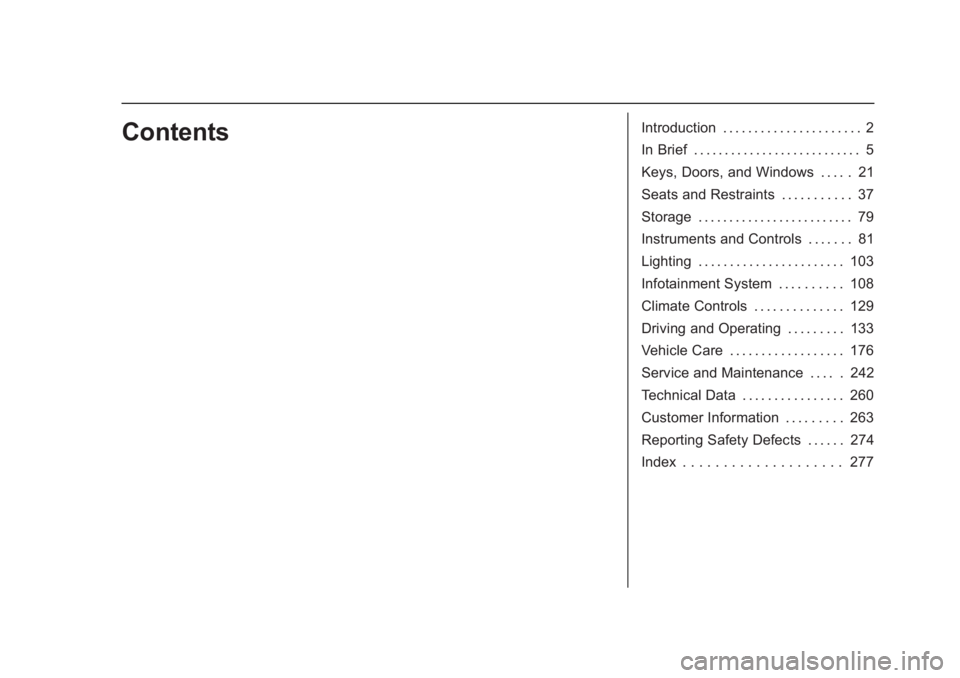
Chevrolet City Express Owner Manual (GMNA-Localizing-U.S./Canada-
11683523) - 2018 - CRC - 7/11/17
ContentsIntroduction . . . . . . . . . . . . . . . . . . . . . . 2
In Brief . . . . . . . . . . . . . . . . . . . . . . . . . . . 5
Keys, Doors, and Windows . . . . . 21
Seats and Restraints . . . . . . . . . . . 37
Storage . . . . . . . . . . . . . . . . . . . . . . . . . 79
Instruments and Controls . . . . . . . 81
Lighting . . . . . . . . . . . . . . . . . . . . . . . 103
Infotainment System . . . . . . . . . . 108
Climate Controls . . . . . . . . . . . . . . 129
Driving and Operating . . . . . . . . . 133
Vehicle Care . . . . . . . . . . . . . . . . . . 176
Service and Maintenance . . . . . 242
Technical Data . . . . . . . . . . . . . . . . 260
Customer Information . . . . . . . . . 263
Reporting Safety Defects . . . . . . 274
Index . . . . . . . . . . . . . . . . . . . . 277
Page 38 of 287
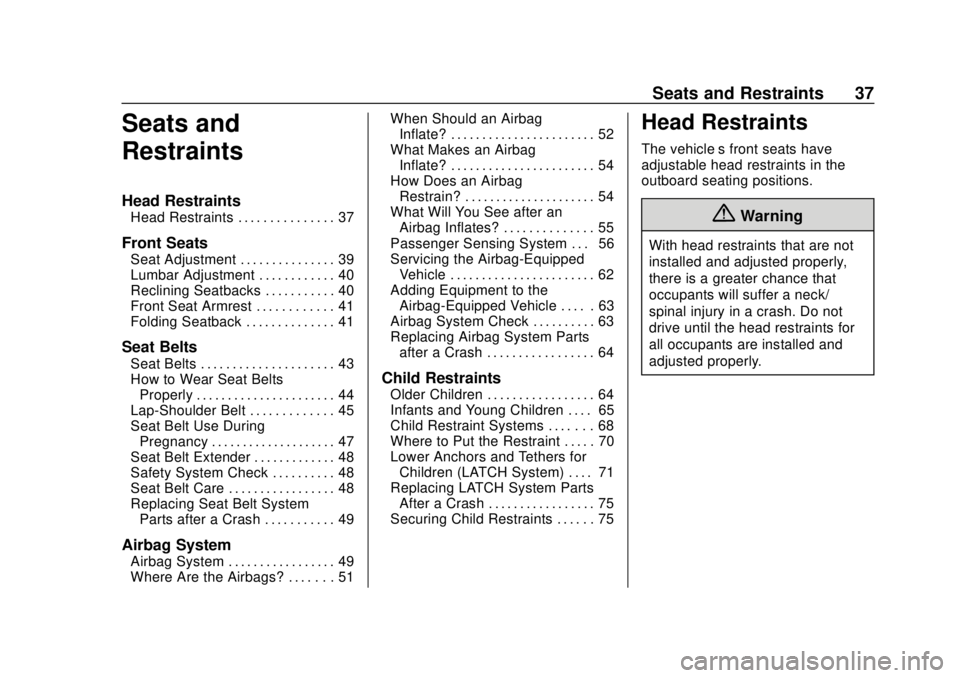
Chevrolet City Express Owner Manual (GMNA-Localizing-U.S./Canada-
11683523) - 2018 - CRC - 7/10/17
Seats and Restraints 37
Seats and
Restraints
Head Restraints
Head Restraints . . . . . . . . . . . . . . . 37
Front Seats
Seat Adjustment . . . . . . . . . . . . . . . 39
Lumbar Adjustment . . . . . . . . . . . . 40
Reclining Seatbacks . . . . . . . . . . . 40
Front Seat Armrest . . . . . . . . . . . . 41
Folding Seatback . . . . . . . . . . . . . . 41
Seat Belts
Seat Belts . . . . . . . . . . . . . . . . . . . . . 43
How to Wear Seat BeltsProperly . . . . . . . . . . . . . . . . . . . . . . 44
Lap-Shoulder Belt . . . . . . . . . . . . . 45
Seat Belt Use During Pregnancy . . . . . . . . . . . . . . . . . . . . 47
Seat Belt Extender . . . . . . . . . . . . . 48
Safety System Check . . . . . . . . . . 48
Seat Belt Care . . . . . . . . . . . . . . . . . 48
Replacing Seat Belt System Parts after a Crash . . . . . . . . . . . 49
Airbag System
Airbag System . . . . . . . . . . . . . . . . . 49
Where Are the Airbags? . . . . . . . 51 When Should an Airbag
Inflate? . . . . . . . . . . . . . . . . . . . . . . . 52
What Makes an Airbag Inflate? . . . . . . . . . . . . . . . . . . . . . . . 54
How Does an Airbag
Restrain? . . . . . . . . . . . . . . . . . . . . . 54
What Will You See after an Airbag Inflates? . . . . . . . . . . . . . . 55
Passenger Sensing System . . . 56
Servicing the Airbag-Equipped Vehicle . . . . . . . . . . . . . . . . . . . . . . . 62
Adding Equipment to the Airbag-Equipped Vehicle . . . . . 63
Airbag System Check . . . . . . . . . . 63
Replacing Airbag System Parts after a Crash . . . . . . . . . . . . . . . . . 64
Child Restraints
Older Children . . . . . . . . . . . . . . . . . 64
Infants and Young Children . . . . 65
Child Restraint Systems . . . . . . . 68
Where to Put the Restraint . . . . . 70
Lower Anchors and Tethers forChildren (LATCH System) . . . . 71
Replacing LATCH System Parts After a Crash . . . . . . . . . . . . . . . . . 75
Securing Child Restraints . . . . . . 75
Head Restraints
The vehicle’s front seats have
adjustable head restraints in the
outboard seating positions.
{Warning
With head restraints that are not
installed and adjusted properly,
there is a greater chance that
occupants will suffer a neck/
spinal injury in a crash. Do not
drive until the head restraints for
all occupants are installed and
adjusted properly.
Page 39 of 287
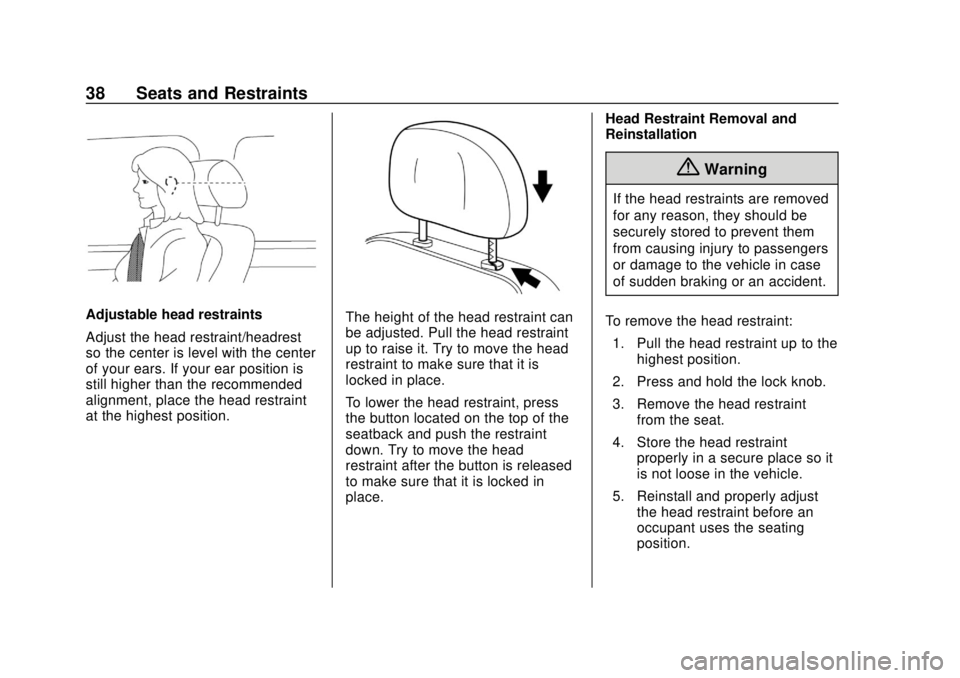
Chevrolet City Express Owner Manual (GMNA-Localizing-U.S./Canada-
11683523) - 2018 - CRC - 7/10/17
38 Seats and Restraints
Adjustable head restraints
Adjust the head restraint/headrest
so the center is level with the center
of your ears. If your ear position is
still higher than the recommended
alignment, place the head restraint
at the highest position.The height of the head restraint can
be adjusted. Pull the head restraint
up to raise it. Try to move the head
restraint to make sure that it is
locked in place.
To lower the head restraint, press
the button located on the top of the
seatback and push the restraint
down. Try to move the head
restraint after the button is released
to make sure that it is locked in
place.Head Restraint Removal and
Reinstallation
{Warning
If the head restraints are removed
for any reason, they should be
securely stored to prevent them
from causing injury to passengers
or damage to the vehicle in case
of sudden braking or an accident.
To remove the head restraint: 1. Pull the head restraint up to the highest position.
2. Press and hold the lock knob.
3. Remove the head restraint from the seat.
4. Store the head restraint properly in a secure place so it
is not loose in the vehicle.
5. Reinstall and properly adjust the head restraint before an
occupant uses the seating
position.
Page 40 of 287
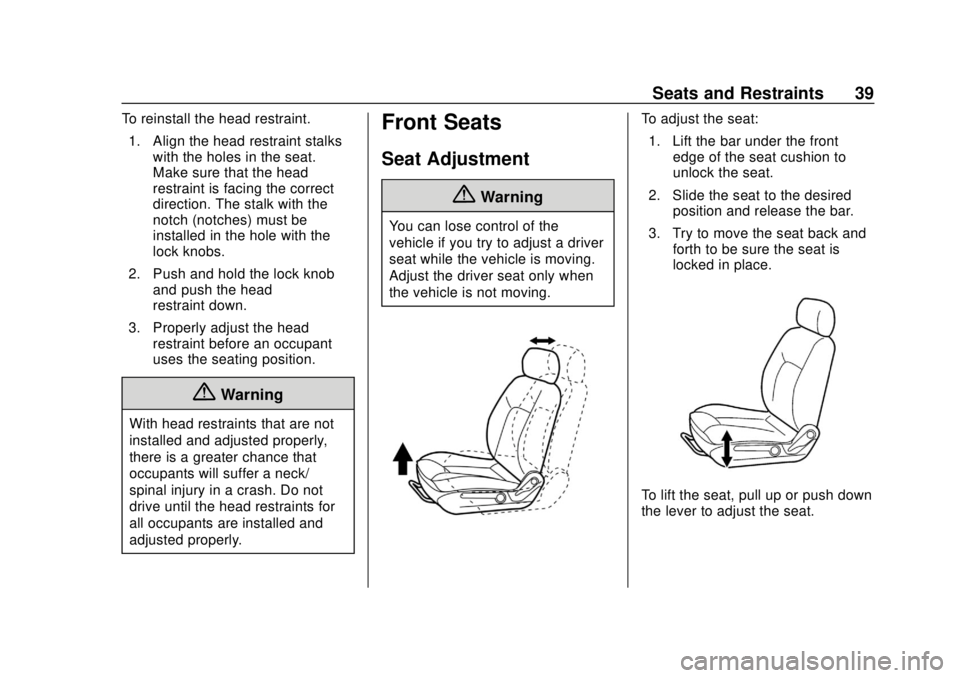
Chevrolet City Express Owner Manual (GMNA-Localizing-U.S./Canada-
11683523) - 2018 - CRC - 7/10/17
Seats and Restraints 39
To reinstall the head restraint.1. Align the head restraint stalks with the holes in the seat.
Make sure that the head
restraint is facing the correct
direction. The stalk with the
notch (notches) must be
installed in the hole with the
lock knobs.
2. Push and hold the lock knob and push the head
restraint down.
3. Properly adjust the head restraint before an occupant
uses the seating position.
{Warning
With head restraints that are not
installed and adjusted properly,
there is a greater chance that
occupants will suffer a neck/
spinal injury in a crash. Do not
drive until the head restraints for
all occupants are installed and
adjusted properly.
Front Seats
Seat Adjustment
{Warning
You can lose control of the
vehicle if you try to adjust a driver
seat while the vehicle is moving.
Adjust the driver seat only when
the vehicle is not moving.
To adjust the seat:
1. Lift the bar under the front edge of the seat cushion to
unlock the seat.
2. Slide the seat to the desired position and release the bar.
3. Try to move the seat back and forth to be sure the seat is
locked in place.
To lift the seat, pull up or push down
the lever to adjust the seat.
Page 41 of 287

Chevrolet City Express Owner Manual (GMNA-Localizing-U.S./Canada-
11683523) - 2018 - CRC - 7/10/17
40 Seats and Restraints
Lumbar Adjustment
On the driver seat, move the lever
on the inboard side of the seat
forward or rearward.
Reclining Seatbacks
{Warning
If either seatback is not locked, it
could move forward in a sudden
stop or crash. That could cause
injury to the person sitting there.(Continued)
Warning (Continued)
Always push and pull on the
seatbacks to be sure they are
locked.
To recline the seatback:
1. Lift the lever on the side of the seat.
2. Move the seatback to the desired position, and then
release the lever to lock the
seatback in place. 3. Push and pull on the seatback
to make sure it is locked.
To return the seatback to the upright
position: 1. Lift the lever fully without applying pressure to the
seatback, and the seatback will
return to the upright position.
2. Push and pull on the seatback to make sure it is locked.
{Warning
Sitting in a reclined position when
the vehicle is in motion can be
dangerous. Even when buckled
up, the seat belts cannot do
their job.
The shoulder belt will not be
against your body. Instead, it will
be in front of you. In a crash, you
could go into it, receiving neck or
other injuries.
(Continued)
Page 42 of 287

Chevrolet City Express Owner Manual (GMNA-Localizing-U.S./Canada-
11683523) - 2018 - CRC - 7/10/17
Seats and Restraints 41
Warning (Continued)
The lap belt could go up over
your abdomen. The belt forces
would be there, not at your pelvic
bones. This could cause serious
internal injuries.
For proper protection when the
vehicle is in motion, have the
seatback upright. Then sit well
back in the seat and wear the
seat belt properly.
Do not have a seatback reclined if
the vehicle is moving.
Front Seat Armrest
There is an armrest on the inboard
side of the driver seat. To raise or
lower the armrest, push up or pull
down on the armrest.
Folding Seatback
The front passenger seatback may
fold flat.
{Warning
If you fold the seatback forward to
carry longer objects, such as skis,
be sure any such cargo is not
near an airbag. In a crash, an
inflating airbag might force that
object toward a person. This
could cause severe injury or even
death. Secure objects away from
the area in which an airbag would
inflate. For more information, see
Where Are the Airbags?051 and
Vehicle Load Limits 0140.
{Warning
Things you put on this seatback
can strike and injure people in a
sudden stop or turn, or in a crash.
Remove or secure all items
before driving.
Page 43 of 287
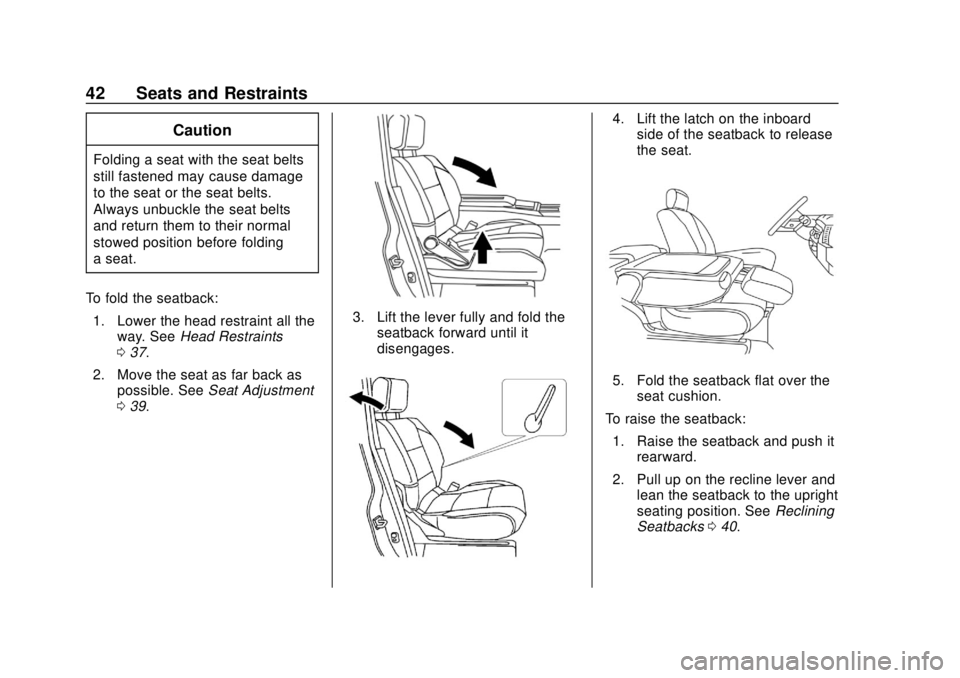
Chevrolet City Express Owner Manual (GMNA-Localizing-U.S./Canada-
11683523) - 2018 - CRC - 7/10/17
42 Seats and Restraints
Caution
Folding a seat with the seat belts
still fastened may cause damage
to the seat or the seat belts.
Always unbuckle the seat belts
and return them to their normal
stowed position before folding
a seat.
To fold the seatback: 1. Lower the head restraint all the way. See Head Restraints
0 37.
2. Move the seat as far back as possible. See Seat Adjustment
0 39.
3. Lift the lever fully and fold the
seatback forward until it
disengages.
4. Lift the latch on the inboardside of the seatback to release
the seat.
5. Fold the seatback flat over the
seat cushion.
To raise the seatback: 1. Raise the seatback and push it rearward.
2. Pull up on the recline lever and lean the seatback to the upright
seating position. See Reclining
Seatbacks 040.
Page 44 of 287
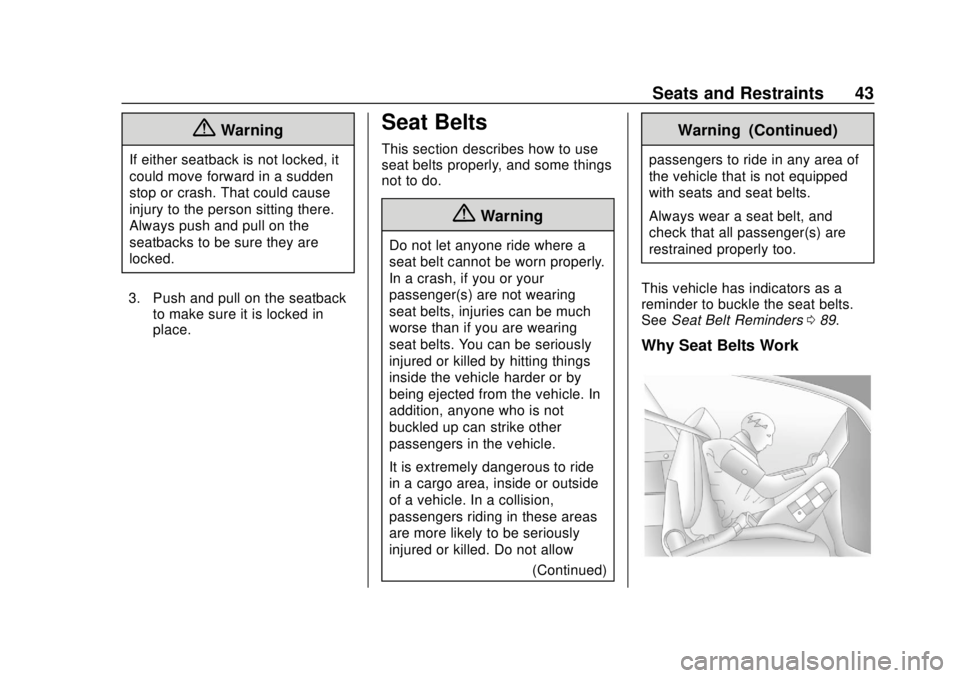
Chevrolet City Express Owner Manual (GMNA-Localizing-U.S./Canada-
11683523) - 2018 - CRC - 7/10/17
Seats and Restraints 43
{Warning
If either seatback is not locked, it
could move forward in a sudden
stop or crash. That could cause
injury to the person sitting there.
Always push and pull on the
seatbacks to be sure they are
locked.
3. Push and pull on the seatback to make sure it is locked in
place.
Seat Belts
This section describes how to use
seat belts properly, and some things
not to do.
{Warning
Do not let anyone ride where a
seat belt cannot be worn properly.
In a crash, if you or your
passenger(s) are not wearing
seat belts, injuries can be much
worse than if you are wearing
seat belts. You can be seriously
injured or killed by hitting things
inside the vehicle harder or by
being ejected from the vehicle. In
addition, anyone who is not
buckled up can strike other
passengers in the vehicle.
It is extremely dangerous to ride
in a cargo area, inside or outside
of a vehicle. In a collision,
passengers riding in these areas
are more likely to be seriously
injured or killed. Do not allow
(Continued)
Warning (Continued)
passengers to ride in any area of
the vehicle that is not equipped
with seats and seat belts.
Always wear a seat belt, and
check that all passenger(s) are
restrained properly too.
This vehicle has indicators as a
reminder to buckle the seat belts.
See Seat Belt Reminders 089.
Why Seat Belts Work
Page 45 of 287

Chevrolet City Express Owner Manual (GMNA-Localizing-U.S./Canada-
11683523) - 2018 - CRC - 7/10/17
44 Seats and Restraints
When riding in a vehicle, you travel
as fast as the vehicle does. If the
vehicle stops suddenly, you keep
going until something stops you.
It could be the windshield, the
instrument panel, or the seat belts!
When you wear a seat belt, you and
the vehicle slow down together.
There is more time to stop because
you stop over a longer distance and,
when worn properly, your strongest
bones take the forces from the seat
belts. That is why wearing seat belts
makes such good sense.
Questions and Answers About
Seat Belts
Q: Will I be trapped in the vehicleafter a crash if I am wearing a
seat belt?
A: You could be—whether you are
wearing a seat belt or not. Your
chance of being conscious
during and after a crash, so you
can unbuckle and get out, is
much greater if you are belted. Q: If my vehicle has airbags, why
should I have to wear seat
belts?
A: Airbags are supplemental
systems only. They work with
seat belts —not instead of them.
Whether or not an airbag is
provided, all occupants still have
to buckle up to get the most
protection.
Also, in nearly all states and in
all Canadian provinces, the law
requires wearing seat belts.
How to Wear Seat Belts
Properly
This section is only for people of
adult size.
There are special things to know
about seat belts and children, and
there are different rules for smaller
children and infants. If a child will be
riding in the vehicle, see Older
Children 064 orInfants and Young
Children 065. Follow those rules for
everyone's protection. It is very important for all occupants
to buckle up. Statistics show that
unbelted people are hurt more often
in crashes than those who are
wearing seat belts.
There are important things to know
about wearing a seat belt properly.
.
Sit up straight and always keep
your feet on the floor in front
of you.
. Always use the correct buckle
for your seating position.
. Wear the lap part of the belt low
and snug on the hips, just
touching the thighs. In a crash,
Page 46 of 287
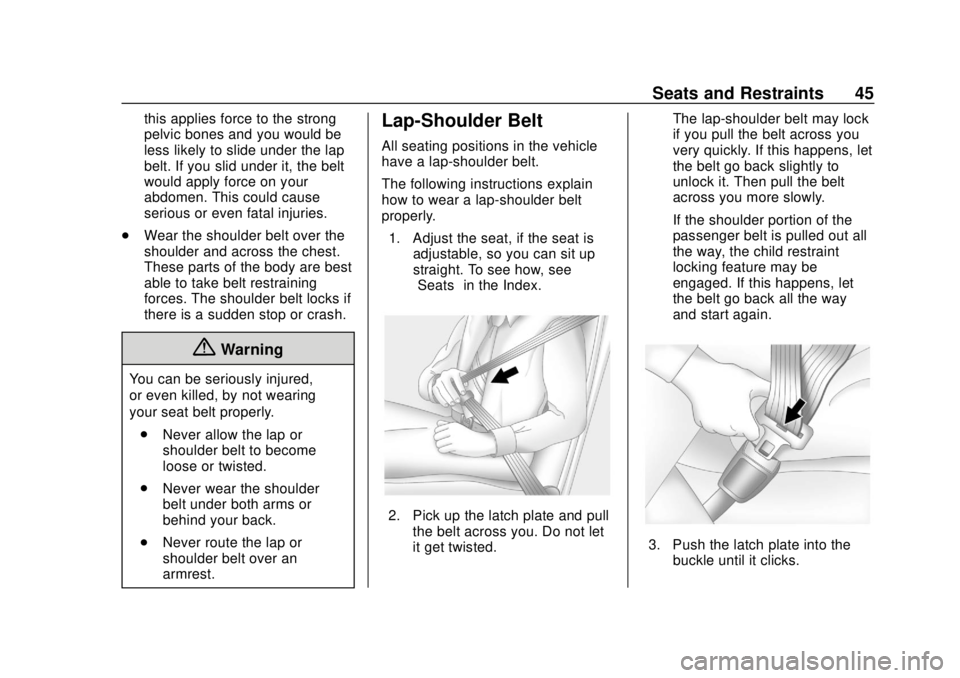
Chevrolet City Express Owner Manual (GMNA-Localizing-U.S./Canada-
11683523) - 2018 - CRC - 7/10/17
Seats and Restraints 45
this applies force to the strong
pelvic bones and you would be
less likely to slide under the lap
belt. If you slid under it, the belt
would apply force on your
abdomen. This could cause
serious or even fatal injuries.
. Wear the shoulder belt over the
shoulder and across the chest.
These parts of the body are best
able to take belt restraining
forces. The shoulder belt locks if
there is a sudden stop or crash.
{Warning
You can be seriously injured,
or even killed, by not wearing
your seat belt properly.
. Never allow the lap or
shoulder belt to become
loose or twisted.
. Never wear the shoulder
belt under both arms or
behind your back.
. Never route the lap or
shoulder belt over an
armrest.
Lap-Shoulder Belt
All seating positions in the vehicle
have a lap-shoulder belt.
The following instructions explain
how to wear a lap-shoulder belt
properly.
1. Adjust the seat, if the seat is adjustable, so you can sit up
straight. To see how, see
“Seats” in the Index.
2. Pick up the latch plate and pull
the belt across you. Do not let
it get twisted. The lap-shoulder belt may lock
if you pull the belt across you
very quickly. If this happens, let
the belt go back slightly to
unlock it. Then pull the belt
across you more slowly.
If the shoulder portion of the
passenger belt is pulled out all
the way, the child restraint
locking feature may be
engaged. If this happens, let
the belt go back all the way
and start again.
3. Push the latch plate into the
buckle until it clicks.